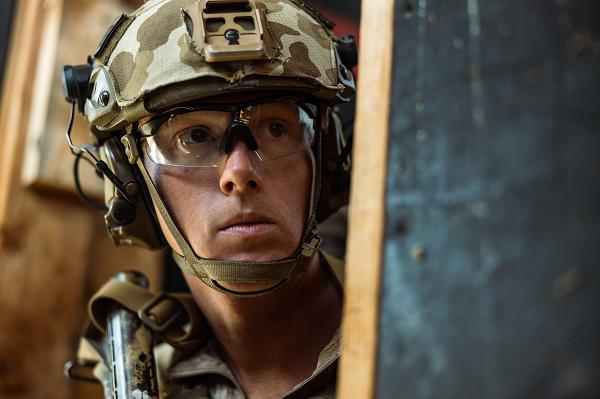
Camp Pendleton, California. (October 15, 2024): From fighting door-to-door in World War II to clearing rooms in Iraq, the Marines have a long and tortured history with urban warfare. In this photo by Lance Corporal Jordan Searls, Sergeant Trent Hau assesses his surroundings prior to conducting a room clearing drill during the Marine Raid Leaders Course. Operated by the Marine’s Expeditionary Operations Training Group, the course teaches Marines and Sailors how to survive urban combat.
During World War II, Army Soldiers cleared buildings all the way to Berlin and the Marines fought it out in the cities of Hue, Vietnam. Recent experience in Fallujah, Iraq, has underscored the need for more training in close quarter combat. Due to its chaotic, claustrophobic nature, urban combat is perhaps the deadliest chore in the infantry.
Raiders seize buildings by breaching doors and going room-to-room to root out the enemy. They are most vulnerable when attempting entry so each raid begins by “setting” security and establishing a perimeter. Next, Raiders practice dozens of entry methods using tools, chemicals, and explosives. Once inside, the troops learn how to safely sweep a building in which the enemy could be anywhere. Confronting these dangers requires nerve, training, and constant practice.
The Marine’s Raid Leader course teaches the lessons learned in past conflicts by current urban combat veterans of Iraq and Afghanistan as instructors. In extremely realistic simulations, the two-week program teaches students how to breach structures, clear rooms, and the rules regarding detaining non-combatants.
The first week consists of marksmanship, firing weapons in tight spaces, and operating as a team when clearing rooms. The second week is dedicated to actual breaching of buildings using various tools and explosives, including brute force. Teams also learn how to set security and provide cover for fellow Marines working the structure.
The key is to teach Marines how and when to use these techniques so they can rehearse and practice them back at their unit. Through these schools, the Marines pass on their hard-won lessons to the next generation of warfighters.


